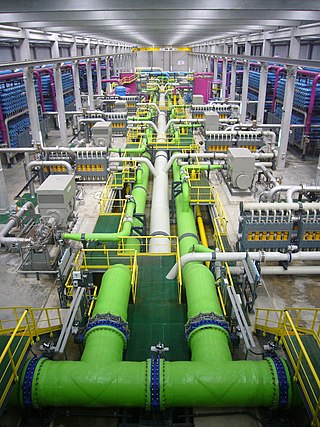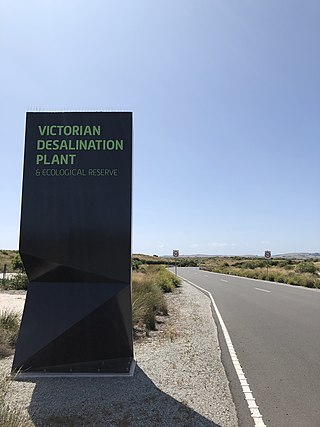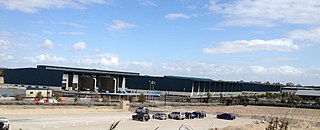
Brine is water with a high-concentration solution of salt. In diverse contexts, brine may refer to the salt solutions ranging from about 3.5% up to about 26%. Brine forms naturally due to evaporation of ground saline water but it is also generated in the mining of sodium chloride. Brine is used for food processing and cooking, for de-icing of roads and other structures, and in a number of technological processes. It is also a by-product of many industrial processes, such as desalination, so it requires wastewater treatment for proper disposal or further utilization.

Desalination is a process that takes away mineral components from saline water. More generally, desalination is the removal of salts and minerals from a target substance, as in soil desalination, which is an issue for agriculture. Saltwater is desalinated to produce water suitable for human consumption or irrigation. The by-product of the desalination process is brine. Desalination is used on many seagoing ships and submarines. Most of the modern interest in desalination is focused on cost-effective provision of fresh water for human use. Along with recycled wastewater, it is one of the few rainfall-independent water resources.

Forward osmosis (FO) is an osmotic process that, like reverse osmosis (RO), uses a semi-permeable membrane to effect separation of water from dissolved solutes. The driving force for this separation is an osmotic pressure gradient, such that a "draw" solution of high concentration, is used to induce a net flow of water through the membrane into the draw solution, thus effectively separating the feed water from its solutes. In contrast, the reverse osmosis process uses hydraulic pressure as the driving force for separation, which serves to counteract the osmotic pressure gradient that would otherwise favor water flux from the permeate to the feed. Hence significantly more energy is required for reverse osmosis compared to forward osmosis.
Multi-stage flash distillation (MSF) is a water desalination process that distills sea water by flashing a portion of the water into steam in multiple stages of what are essentially countercurrent heat exchangers. Current MSF facilities may have as many as 30 stages.
Solar desalination is a desalination technique powered by solar energy. The two common methods are direct (thermal) and indirect (photovoltaic).

A reverse osmosis plant is a manufacturing plant where the process of reverse osmosis takes place. Reverse osmosis is a common process to purify or desalinate contaminated water by forcing water through a membrane. Water produced by reverse osmosis may be used for a variety of purposes, including desalination, wastewater treatment, concentration of contaminants, and the reclamation of dissolved minerals. An average modern reverse osmosis plant needs six kilowatt-hours of electricity to desalinate one cubic metre of water. The process also results in an amount of salty briny waste. The challenge for these plants is to find ways to reduce energy consumption, use sustainable energy sources, improve the process of desalination and to innovate in the area of waste management to deal with the waste. Self-contained water treatment plants using reverse osmosis, called reverse osmosis water purification units, are normally used in a military context.
A solar-powered desalination unit produces potable water from saline water through direct or indirect methods of desalination powered by sunlight. Solar energy is the most promising renewable energy source due to its ability to drive the more popular thermal desalination systems directly through solar collectors and to drive physical and chemical desalination systems indirectly through photovoltaic cells.

CETO is a wave-energy technology that converts kinetic energy from ocean swell into electrical power and directly desalinates freshwater through reverse osmosis. The technology was developed and tested onshore and offshore in Fremantle, Western Australia. In early 2015 a CETO 5 production installation was commissioned and connected to the grid. As of January 2016 all the electricity generated is being purchased to contribute towards the power requirements of HMAS Stirling naval base at Garden Island, Western Australia. Some of the energy will also be used directly to desalinate water.

The Victorian Desalination Plant is a water desalination plant in Dalyston, on the Bass Coast in southern Victoria, Australia. The project was announced by Premier Steve Bracks in June 2007, at the height of the millennium drought when Melbourne's water storage levels dropped to 28.4%, a drop of more than 20% from the previous year. Increased winter-spring rains after mid-2007 took water storage levels above 40%, but it was not until 2011 that storages returned to pre-2006 levels.

A pressure exchanger transfers pressure energy from a high pressure fluid stream to a low pressure fluid stream. Many industrial processes operate at elevated pressures and have high pressure waste streams. One way of providing a high pressure fluid to such a process is to transfer the waste pressure to a low pressure stream using a pressure exchanger.
Energy Recovery Inc. (NASDAQ: ERII) is an American manufacturer of energy recovery devices for water and CO2 refrigeration industries.
Richard Lindsay Stover, Ph.D., pioneered the development of the PX Pressure Exchanger energy recovery device Energy recovery that is currently in use in most seawater reverse osmosis desalination plants in existence today.
The Sydney Desalination Plant also known as the Kurnell Desalination Plant is a potable drinking water desalination plant that forms part of the water supply system of Greater Metropolitan Sydney. The plant is located in the Kurnell industrial estate, in Southern Sydney in the Australian state of New South Wales. The plant uses reverse osmosis filtration membranes to remove salt from seawater and is powered using renewable energy, supplied to the national power grid from the Infigen Energy–owned Capital Wind Farm located at Bungendore.
Reverse osmosis (RO) is a water purification process that uses a semi-permeable membrane to separate water molecules from other substances. RO applies pressure to overcome osmotic pressure that favors even distributions. RO can remove dissolved or suspended chemical species as well as biological substances, and is used in industrial processes and the production of potable water. RO retains the solute on the pressurized side of the membrane and the purified solvent passes to the other side. It relies on the relative sizes of the various molecules to decide what passes through. "Selective" membranes reject large molecules, while accepting smaller molecules.

The Adelaide Desalination plant (ADP), formerly known as the Port Stanvac Desalination Plant, is a sea water reverse osmosis desalination plant located in Lonsdale, South Australia which has the capacity to provide the city of Adelaide with up to 50% of its drinking water needs.

The Binningup Desalination Plant is a desalination plant near Binningup, Western Australia, about 150 kilometres (93 mi) south of Perth. It supplies water to the state capital Perth, as well as the nearby regional city of Bunbury and is known as the Southern Seawater Desalination Project It was designed to initially deliver 50 gigalitres of potable water per year but was expanded to deliver 100 gigalitres of potable water per year, or 33% of Perth's requirements. The plant was officially opened in September 2011 at reduced output, and was completed and operating at full capacity in January 2013.

Australia is the driest habitable continent on Earth and its installed desalination capacity has been increasing. Until a few decades ago, Australia met its demands for water by drawing freshwater from dams and water catchments. As a result of the water supply crisis during the severe 1997–2009 drought, state governments began building desalination plants that purify seawater using reverse osmosis technology. Approximately one percent of the world's drinkable water originates from desalination plants.
The Minjur Desalination Plant is a reverse osmosis, water desalination plant at Kattupalli village, a northern suburb of Chennai, India, on the coast of the Bay of Bengal that supplies water to the city of Chennai. Built on a 60-acre site, it is the largest desalination plant in India. Construction works were carried out by the Indian company IVRCL and the Spanish company Abengoa, under the direction of the Project Manager Fernando Portillo Vallés and the Construction Manager Juan Ignacio Jiménez-Velasco, who returned to Europe after the inauguration of the plant to work on renewable energy projects. Originally scheduled to be operational by January 2009, the work on the plant was delayed due to Cyclone Nisha in October 2008, which damaged a portion of the completed marine works and destroyed the cofferdam meant for the installation of transition pipes. The trial runs were completed in June 2010 and the plant was opened in July 2010. Water from the plant will be utilised chiefly for industrial purposes such as the Ennore Port and North Chennai Thermal Power Station. However, during droughts, water from the plant will be supplied to the public, serving an estimated population of 1,000,000.

Fluid Equipment Development Company (FEDCO) is a Michigan-based designer and manufacturer of high-pressure feed pumps and brine energy recovery devices (ERDs) for brackish water reverse osmosis (BWRO) and seawater reverse osmosis (SWRO) systems. With over 3,500 units in service, FEDCO pumps and ERDs can be found on 6 continents, specifically in areas with little freshwater and rainfall or dense populations. Reverse osmosis (RO) applications including SWRO plants, boiler feedwater, oil platforms, ocean liners, military systems, hotels and resorts.
There are approximately 16,000 operational desalination plants, located across 177 countries, which generate an estimated 95 million m3/day of fresh water. Micro desalination plants operate near almost every natural gas or fracking facility in the United States. Furthermore, micro desalination facilities exist in textile, leather, food industries, etc.













